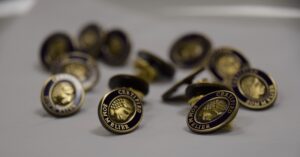
 When Madame Clicquot Ponsardin’s husband died in 1805 and she took over his wine business at age 27, no one expected it to succeed. Faced with scandal – this was not considered an appropriate pursuit for a woman OR a widower – and a fledging product, the Clicquot House adapted, improved and expanded under her leadership. And when demand for champagne increased after the Napoleonic, the widow Clicquot needed to improve her production process. Up to this point, removing dead yeast by pouring the finished wine from one bottle to another once it had consumed the sugar was costly, time-consuming and wasteful. As we all now know, Clicquot devised the infamous riddling method to solve this challenge. This was a rack of sorts that could hold bottles at an inverted angle, rotating them as they ferment, so yeast could gather at the neck to be disgorged as a pellet once secondary fermentation was complete. Voilà, the méthode traditionnelle was born and continues to be used today in wineries across the UK and the world, albeit with some mechanical upgrades.
When Madame Clicquot Ponsardin’s husband died in 1805 and she took over his wine business at age 27, no one expected it to succeed. Faced with scandal – this was not considered an appropriate pursuit for a woman OR a widower – and a fledging product, the Clicquot House adapted, improved and expanded under her leadership. And when demand for champagne increased after the Napoleonic, the widow Clicquot needed to improve her production process. Up to this point, removing dead yeast by pouring the finished wine from one bottle to another once it had consumed the sugar was costly, time-consuming and wasteful. As we all now know, Clicquot devised the infamous riddling method to solve this challenge. This was a rack of sorts that could hold bottles at an inverted angle, rotating them as they ferment, so yeast could gather at the neck to be disgorged as a pellet once secondary fermentation was complete. Voilà, the méthode traditionnelle was born and continues to be used today in wineries across the UK and the world, albeit with some mechanical upgrades. “The world is in perpetual motion, and we must invent the things of tomorrow. One must go before others, be determined and exacting, and let your intelligence direct your life. Act with audacity.”
– Madame Clicquot
Indeed, the UK wine industry, in particular, has followed not only in the inventive methods of Madame Clicquot, but also often with innovative and powerful women in winemaking at the helm. Traditionally, wine industries in most of the world have been dominated by generations of white men. A combination of social and familial norms, lack of access to training and education, assumptions about the “physical work” of a vineyard, and limited leisure and work opportunities outside the home meant that women have historically been excluded from both the production and consumption of wine. Wine sociologist Charles Rigaux has found that even throughout the 20th Century, “when the time comes for a winegrower to pass on their business to their children, they will often choose their son over their daughter.” Even still, some of the oldest and most prestigious vines in the world are referred to as “patriarchal” with attempts being made to preserve their DNA, quite literally, to “propagate the species.” Moreover, in 2020, the Diversity in Wine survey revealed that women who ran wine programs in hotels and restaurants were routinely overlooked by guests who wanted to “speak to the sommelier”, expecting a man to be in charge. More disturbingly, in 2021, 22 members of the American Court of Master Sommeliers were investigated on allegations of sexual harassment, with 6 members being permanently expelled. While we know that such incidences are not limited to the wine industry alone, inequitable (and sometimes violent) conditions continue to exist.
The UK wine industry offers something different. First, it is a newer industry, with 943 vineyards as of June 2023 – a substantial 74% of which have been planted in the last five years. While newness certainly comes with growing pains, it also means a freedom from the cultural, historical and gendered norms of other regions. Laithwaite’s reports that gender distinction among Masters of Wine designations in the UK is creeping closer to parity, with 36% now identifying as female. Women in wine leadership also seems to be more of a growing norm than an exception in England and is reflected from the vineyard to the crush pad to ownership and creative direction. Two notable examples are head winemakers Cherie Spriggs (Nyetimber) who won the 2018 International Wine Challenge’s Sparkling Winemaker of the Year, and Emma Rice – UK Vineyards Association Winemaker of the Year in both 2014 and 2016 (while at Hattingley).
The story of Madame Clicquot reminds us that women in winemaking have always been significant, and critical, to the business of making wine with their capacity to turn an industry (quite literally in the widow Clicquot’s case!) upside down. Sparking, in particular, has been well-led by women but often by accident rather than default and until recently usually required the death or abdication of a husband or next male heir. Now, women are taking the industry by storm, on their own terms, and producing some of the best wines this country has ever seen.
Not only are the opportunities for women in wine expanding; research shows that companies in the top quartile of gender diversity among executive leadership are 25 percent more likely to experience above average profits. Contrary to requirements of the past, women no longer need to be widowed or scandalised to spearhead a wine label. On the whole, women are making, consuming, and investing in wine with increasing impact. In fact, in 2022, Sotheby’s Global Wine and Spirits reported “year-on-year” growth in women-led purchases, “driven by women collectors most prominently in North America, followed by Europe, then Asia.” This bodes well for the UK industry as women show “much more willingness to experiment, engage with new regions and styles and explore beyond the traditional confines of the most established fine wine.” If women now account for 80% of wine purchasing in the UK and 57% of overall spend is a result of direct-to-consumer purchases, this likely means that 8 out of 10 bottles purchased on your website or in your wineshop are being bought by women.
There is much to celebrate in UK fizz, and there are many wineries uncorking the traditionally male industry. Some honourable mentions in this space include.
There are so many more and we’d love to hear from you if you’d like to be featured in a later post. Gender diversity can, and should, be part of your brand, with several strategies available to ensure that your marketing plan not only reflects your values as a vineyard or winery but serves to increase loyalty and recognition and translates to even more bottles walking out your cellar door.
With any campaign focused around a cause, there is a need to balance the genuine and authentic desire to transmit equity with the need to turn a profit. With creativity, sensitivity, and awareness, both can happen. Talk to us about how to make gender equality and the role of women in wine part of your marketing strategy!